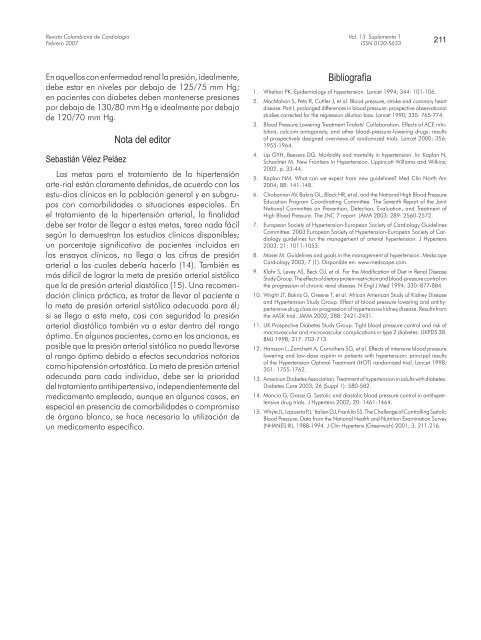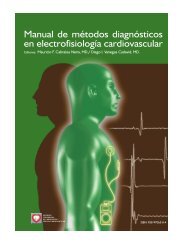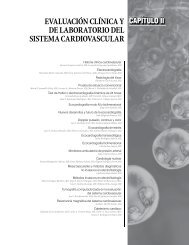GUIAS HIPERTENSION ARTERIAL.indb - Scc
GUIAS HIPERTENSION ARTERIAL.indb - Scc
GUIAS HIPERTENSION ARTERIAL.indb - Scc
Create successful ePaper yourself
Turn your PDF publications into a flip-book with our unique Google optimized e-Paper software.
Revista Colombiana de Cardiología<br />
Febrero 2007<br />
En aquellos con enfermedad renal la presión, idealmente,<br />
debe estar en niveles por debajo de 125/75 mm Hg;<br />
en pacientes con diabetes deben mantenerse presiones<br />
por debajo de 130/80 mm Hg e idealmente por debajo<br />
de 120/70 mm Hg.<br />
Sebastián Vélez Peláez<br />
Nota del editor<br />
Las metas para el tratamiento de la hipertensión<br />
arte-rial están claramente definidas, de acuerdo con los<br />
estu-dios clínicos en la población general y en subgrupos<br />
con comorbilidades o situaciones especiales. En<br />
el tratamiento de la hipertensión arterial, la finalidad<br />
debe ser tratar de llegar a estas metas, tarea nada fácil<br />
según lo demuestran los estudios clínicos disponibles;<br />
un porcentaje significativo de pacientes incluidos en<br />
los ensayos clínicos, no llega a las cifras de presión<br />
arterial a las cuales debería hacerlo (14). También es<br />
más difícil de lograr la meta de presión arterial sistólica<br />
que la de presión arterial diastólica (15). Una recomendación<br />
clínica práctica, es tratar de llevar al paciente a<br />
la meta de presión arterial sistólica adecuada para él;<br />
si se llega a esta meta, casi con seguridad la presión<br />
arterial diastólica también va a estar dentro del rango<br />
óptimo. En algunos pacientes, como en los ancianos, es<br />
posible que la presión arterial sistólica no pueda llevarse<br />
al rango óptimo debido a efectos secundarios notorios<br />
como hipotensión ortostática. La meta de presión arterial<br />
adecuada para cada individuo, debe ser la prioridad<br />
del tratamiento antihipertensivo, independientemente del<br />
medicamento empleado, aunque en algunos casos, en<br />
especial en presencia de comorbilidades o compromiso<br />
de órgano blanco, se hace necesaria la utilización de<br />
un medicamento específico.<br />
Vol. 13 Suplemento 1<br />
ISSN 0120-5633<br />
Bibliografía<br />
211<br />
1. Whelton PK. Epidemiology of hypertension. Lancet 1994; 344: 101-106.<br />
2. MacMahon S, Peto R, Cuttler J, et al. Blood pressure, stroke and coronary heart<br />
disease. Part I, prolonged differences in blood pressure: prospective observational<br />
studies corrected for the regression dilution bias. Lancet 1990; 335: 765-774.<br />
3. Blood Pressure Lowering Treatment Trialists‘ Collaboration. Effects of ACE inhibitors,<br />
calcium antagonists, and other blood-pressure-lowering drugs: results<br />
of prospectively designed overviews of randomized trials. Lancet 2000; 356:<br />
1955-1964.<br />
4. Lip GYH, Beevers DG. Morbidity and mortality in hypertension. In: Kaplan N,<br />
Schachter M. New Frontiers in Hypertension. Lippincott Williams and Wilkins;<br />
2002. p. 33-44.<br />
5. Kaplan NM. What can we expect from new guidelines? Med Clin North Am<br />
2004; 88: 141-148.<br />
6. Chobanian AV, Bakris GL, Black HR, et al, and the National High Blood Pressure<br />
Education Program Coordinating Committee. The Seventh Report of the Joint<br />
National Committee on Prevention, Detection, Evaluation, and Treatment of<br />
High Blood Pressure. The JNC 7 report. JAMA 2003; 289: 2560-2572.<br />
7. European Society of Hypertension-European Society of Cardiology Guidelines<br />
Committee. 2003 European Society of Hypertension-European Society of Cardiology<br />
guidelines for the management of arterial hypertension. J Hypertens<br />
2003; 21: 1011-1053.<br />
8. Moser M. Guidelines and goals in the management of hypertension. Medscape<br />
Cardiology 2003; 7 (1). Disponible en: www.medscape.com.<br />
9. Klahr S, Levey AS, Beck GJ, et al. For the Modification of Diet in Renal Disease<br />
Study Group. The effects of dietary protein restriction and blood-pressure control on<br />
the progression of chronic renal disease. N Engl J Med 1994; 330: 877-884.<br />
10. Wright JT, Bakris G, Greene T, et al. African American Study of Kidney Disease<br />
and Hypertension Study Group. Effect of blood pressure lowering and antihypertensive<br />
drug class on progression of hypertensive kidney disease. Results from<br />
the AASK trial. JAMA 2002; 288: 2421-2431.<br />
11. UK Prospective Diabetes Study Group. Tight blood pressure control and risk of<br />
macrovascular and microvascular complications in type 2 diabetes: UKPDS 38.<br />
BMJ 1998; 317: 703-713.<br />
12. Hansson L, Zanchetti A, Carruthers SG, et al. Effects of intensive blood pressure<br />
lowering and low-dose aspirin in patients with hypertension: principal results<br />
of the Hypertension Optimal Treatment (HOT) randomized trial. Lancet 1998;<br />
351: 1755-1762.<br />
13. American Diabetes Association. Treatment of hypertension in adults with diabetes.<br />
Diabetes Care 2003; 26 (Suppl 1): 580-582.<br />
14. Mancia G, Grassi G. Systolic and diastolic blood pressure control in antihypertensive<br />
drug trials. J Hypertens 2002; 20: 1461-1464.<br />
15. Whyte JL, Lapuerta P, L´Italien GJ, Franklin SS. The Challenge of Controlling Systolic<br />
Blood Pressure: Data from the National Health and Nutrition Examination Survey<br />
(NHANES III), 1988-1994. J Clin Hypertens (Greenwich) 2001; 3: 211-216.




